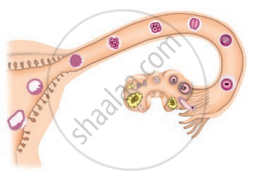Advertisements
Advertisements
प्रश्न
Differentiate between oviparous and viviparous animals.
फरक स्पष्ट करा
उत्तर
| Oviparous animals | Viviparous animals |
| The development of the embryo takes place outside the animal. | The development of the embryo takes place inside the animal. |
| They produce their young ones by laying eggs. | They directly give birth to the young ones. |
| The embryo receives the nutrients from the egg yolk. | The embryo receives the nutrients from the mother. |
| Examples of oviparous animals are insects, fish, reptiles, and birds. | Examples of viviparous animals are cats, dogs, humans, and lions. |
shaalaa.com
Embryo Formation in Viviparous and Oviparous Animals - Young Ones to Adults
या प्रश्नात किंवा उत्तरात काही त्रुटी आहे का?
APPEARS IN
संबंधित प्रश्न
______ is an oviparous animal.
Match the following.
| 1. | Zycote | Asexual Reproduction |
| 2. | Viviparous | Elephant |
| 3. | Endangered animal | Cat |
| 4. | Mudhumalai | Fertilised Egg |
| 5. | Fragmentation | Rhinoceros |
Stages in the life cycle of silkworm are given below. Write them in sequential order.
| Pupa | Egg | Silk moth | Caterpillar |

After Observing above figure, answer the following,
- Read the following statements and label them in the figure.
(i) The part which produces female gametes.
(ii) The part where development of the baby takes place.
(iii) The part through which the developing embryo passes to reach the uterus. - Explain the future development of the embryo that would take place after it gets embedded in the uterus.
Hens and frogs are both oviparous exhibiting different types of fertilisation. Explain.
